Alleviating Shoulder Pain
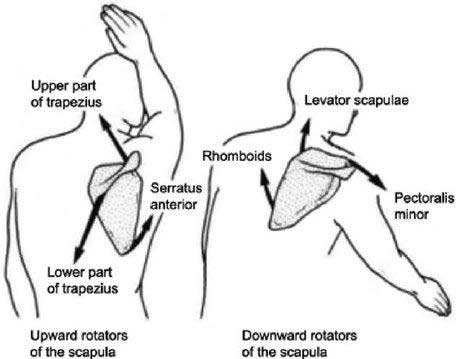
Do you have shoulder pain? There are likely things you can do to improve your pain without medication or surgery. Many people experience shoulder pain as a result of faulty mechanics. In other words, you are moving incorrectly! In most cases, people with general shoulder pain have an imbalance in how their shoulders and shoulder blades (scapulae) move. This is caused by imbalances in muscle activation, strength, and flexibility. In order to move “correctly,” a group of muscles must work together in order to move a body part. In the case of shoulder pain, one muscle often compensates and picks up the slack for “underperforming” or weak muscles. As a result, this can place undue stress on other structures in the shoulder, resulting in pain and loss of function.
The image above is a simple diagram of how these muscles work together during upward rotation (overhead movement) and downward rotation of the scapula.
Most of the time, people tend to rely on the upper trapezius muscle to pick up the slack for weaker muscles that stabilize the scapula; including but not limited to the rotator cuff muscles. This ends up causing the shoulder blade to tip forward or outwards. Tipping forward or outwards = pain and dysfunction because of the shoulder blade “pinches” or presses on other structures. This often manifests in the shrugging of the shoulders with overhead movement. Over time, this can lead to increased shoulder pain due to underlying causes such as rotator cuff tendinopathy, impingement, biceps irritation, etc. The good news is that with the right guidance, you can re-train yourself to restore balance in this musculature by improving strength, stability, and flexibility. In short, it is not always as easy as “fix your posture”! You need to change movement patterns and improve muscle activation in order to maintain good posture and remain pain-free.
Below are examples of scapular dysfunction and muscle imbalance. This person’s right scapula is clearly out of position compared to the left. Picture A shows imbalance at rest, B and D both show “winging” of the scapula, while C shows shrugging and anterior tipping of the scapula. This can easily be missed without proper evaluation!
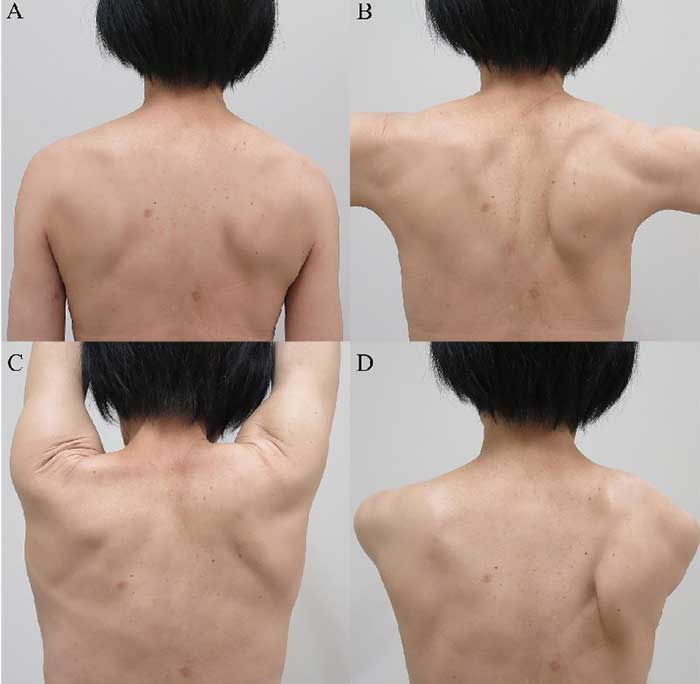
So what can you do? A 2018 study in the International Journal of Sports Medicine (Nowotny) compared the effectiveness of a scapular specific exercise program to that of massage therapy in reducing pain and improving function in patients with scapular dyskinesia. The exercise program also included core strengthening and stabilization. After six weeks, the group of patients who participated in the exercise program saw a much more significant improvement in function (resolution of their dyskinesia) as well as longer-lasting pain relief. In comparison, massage therapy reduced pain effectively but it was temporary and had minimal impact on function. In other words, exercise and re-educating your muscles work very effectively in the treatment of shoulder pain and scapular dyskinesia compared to other approaches.
Below are a few exercises from this study (Nowotny) to help get you started on activating the correct muscles. Remember, it is also important to maintain core stability and strength in order to give yourself a strong and stable base of support. Without a strong base of support, all of your daily activities might as well be performed while standing on a canoe in the ocean – not very stable!
As physical therapists and physical therapist assistants, we specialize in identifying areas of weakness and faulty mechanics. Please feel free to stop by our physical therapy clinic, email us at info@elitesportsandpt.com or call us at 781-573-4205 with any questions or to schedule an initial evaluation. Remember, while these exercises are a good starting point, it is extremely important to receive a proper evaluation from a physical therapist in order to develop an individualized treatment plan. Everyone is different!
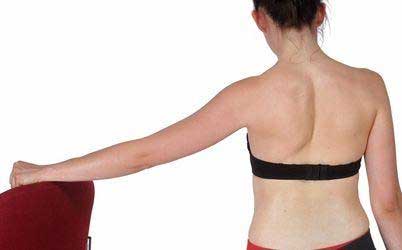
Above: Press forearm down into a stable surface while trying to draw your shoulder blade down and inwards towards your spine. Hold 10 seconds, repeat 20 times.
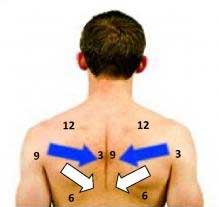
Above: Think of your shoulder blades like clocks. The optimal position for activating your lower trapezius will be drawing your shoulder blades inwards and downwards. This would entail drawing the 7 o’clock on your right shoulder blade down towards the 5 o’clock on your left shoulder blade. This exercise is great for improving your posture and activating the correct musculature. Hold 10 seconds, repeat 20 times. DO NOT SHRUG!
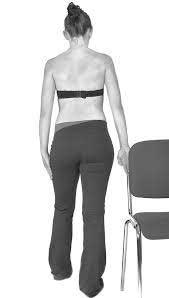
Above: Press forearm into stable surface behind you while again trying to squeeze your scapula downwards and inwards. Hold 10 seconds, repeat 20 times.
References
KONDO, T., OHIRA, Y., UEHARA, T., NODA, K., & IKUSAKA, M. (2017). An unexpected cause of shoulder pain. Cleveland Clinic Journal Of Medicine, 84(4), 276-277. doi: 10.3949/ccjm.84a.16051
Nowotny, J., Kasten, P., Kopkow, C., Biewener, A., & Mauch, F. (2018). Evaluation of a New Exercise Program in the Treatment of Scapular Dyskinesis. International Journal Of Sports Medicine, 39(10), 782-790. doi: 10.1055/a-0608-4584
